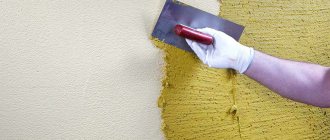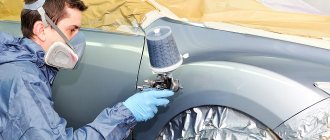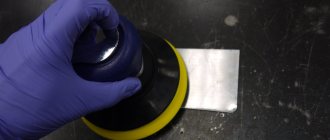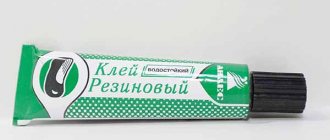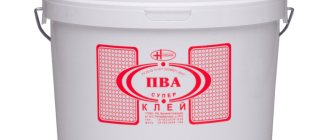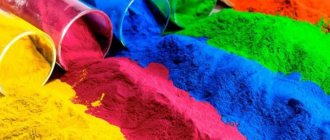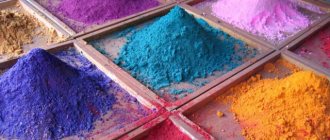Application area
Plasticizing additives are used for the following types of work:
- pouring foundations of various types - from simple strip and columnar to extensive and heavy slab;
- pouring columns, pillars and other reinforced structures;
- installation of bored piles;
- pouring monolithic floors;
- laying bricks, gas silicate blocks, natural and artificial stone
- pouring heated floors;
When pouring a heated floor screed with a concrete mixture with a plasticizer, a high-quality, strong and durable monolithic coating is obtained Source ytimg.com
- façade cladding;
- pouring garden paths, driveways, open summer areas;
- arrangement of swimming pools and artificial decorative reservoirs.
Why do you need a plasticizer?
Throughout its entire service life, the screed in the underfloor heating system regularly heats up and cools down. At the same time, even short-term temperature changes can negatively affect the coating and provoke the formation of microcracks, which significantly reduces the guaranteed service life of the system and affects the temperature of the floor surface, making it ineffective.
The plasticizer makes the screed mortar not only plastic, but also improves its technical properties. It is introduced into the solution when the bulk of water has already been added and the reaction begins when the plasticizer removes excess moisture and pores in the airy composition, compacting it.
The plasticizing composition is sold in convenient canisters of various sizes
A denser solution dries faster, does not shrink much, and prevents moisture from entering.
The plasticizing composition can be:
- Liquid. Convenient to use as it does not require additional preparation.
- Dry. Convenient because it has a long shelf life. It is brought to a working consistency by diluting with water.
- Reinforcing. It contains additional inclusions that strengthen the screed.
- Anti-frost. Used for outdoor work.
Plasticizer properties
A denser solution dries faster, does not shrink much, and prevents moisture from entering.
When pouring a standard concrete solution that does not contain a plasticizer when installing a heated floor system, you may encounter the following problems:
- Uneven heating of the floor surface will be a sign of different heat transfer resistance coefficients in different areas.
- A standard screed from excess moisture will begin to expand and deform, cracks and chips will appear on its surface.
- The thermal conductivity of the slab will decrease due to the formation of cavities inside it.
Filling the screed
Important! Deformation of the screed under the influence of temperature changes leads to a deterioration in the appearance of the final decorative floor covering.
The practice of using a plasticizer in a screed when installing a heated floor system has shown that it guarantees uniform heating of the entire floor surface, increasing the energy efficiency of the system.
Due to the correctly selected plasticizer, the following results can be obtained:
- Premature hardening of the concrete solution is avoided.
- The concrete solution acquires a longer service life.
- The floor covering acquires increased strength and resistance to mechanical stress.
- The solution becomes more elastic, capable of stretching.
- The plasticizer reduces the spreading of the solution.
- No air bubbles form inside the screed.
- The surface of the screed becomes resistant to abrasion.
- The thermal conductivity of the screed increases.
- The screed acquires higher density, uniformity and moisture resistance.
- The coating acquires anti-corrosion properties and resistance to chemical reagents.
Note! By increasing the density of the screed, its tighter contact with the coolant is ensured, and it is also possible to reduce the thickness of the screed itself by up to 15%.
The plasticizer increases the drying time of the screed, but this is not considered a minus if the solution is poured over a large area. If it is necessary to reduce the hardening time of the screed with a plasticizer, special hardening accelerators are introduced into it.
Advantages and disadvantages of using plasticizers
The main advantages of using plasticizers for concrete are the following properties and features that the concrete mixture acquires after adding these additives to it:
- improved flowability - the use of a plasticizer makes the concrete mixture flowable, allowing you to quickly and easily fill formwork and other forms;
- increasing the density of structures;
- reducing the amount of water used to prepare concrete;
- reduction in concrete mixture consumption - due to increased fluidity and workability, concrete consumption is reduced by 20-25%;
- increased frost resistance - by reducing the volume of water in the solution, its resistance to low temperatures improves;
The use of plasticizing antifreeze additives allows concrete work to be carried out throughout the cold season Source moigarazh.ru
- increase in strength - a concrete mixture prepared with the addition of a plasticizer has a strength that is 20-25% greater than that of a concrete mixture without the use of such additives;
- increase in storage time - plasticizing additives allow you to preserve unused solution without adding water to it;
- improvement of adhesion - concrete with plasticizing additives more slowly absorbs moisture from the surface with which it comes into contact (soil, compacted gravel or sand cushion), thereby improving the adhesion force of the hardening solution to it, on average, the adhesion of concrete with a plasticizer is 1.5-2 times higher than that of a similar compound without additives;
- prevention of cracks - concrete with plasticizing additives hardens evenly, so cracks and chips do not appear;
- maintaining the homogeneity of the concrete mixture when transporting it over long distances;
- reduction of concrete shrinkage during its hardening and strength gain.
By introducing plasticizing additives into concrete, it is possible to achieve its maximum homogeneity and density Source egocolor.ru
See also: Catalog of companies that specialize in the construction and repair of foundations
Also, the use of plasticizers increases the service life of the concrete mixer - during the preparation process, the solution with a plasticizing additive sticks less to the walls of the mixer hopper, thereby reducing the load on its drive and electric motor.
The disadvantages of using plasticizing additives are additional financial costs for the purchase and delivery of plasticizers, their precise dosing during the preparation of the concrete mixture
Using additives for heated floors
A plasticizer for underfloor heating screed is a mandatory component. It must be added to the composition to obtain certain properties and characteristics.
- The strength of the poured coating is significantly enhanced.
- Thermal expansion is reduced.
- Thermal conductivity and resistance to temperature fluctuations increase.
- The level of susceptibility to corrosion of heating system elements is reduced.
- The number of air bubbles is significantly reduced.
There is a separate line of additives designed specifically for heated floor screed
. In fact, many who install a floor heating system ignore this recommendation, especially when independently preparing the mixture for pouring the screed. This situation leads to negative consequences:
- The mortar used, especially cement-based, undergoes constant expansion due to temperature fluctuations, which leads to the appearance of deformations and numerous cracks.
- Air bubbles present in the composition contribute to a significant increase in the temperature inside the floor covering, this disrupts the operation of the entire thermal system.
- High thermal conductivity is not inherent in the standard mixture; it is the presence of plasticizers that increases this parameter and increases the overall efficiency.
Thus, when choosing ready-made materials for pouring screed onto a heated floor, it is advisable to check in advance whether they contain the necessary additives.
Types of plasticizers
Depending on the purpose, plasticizing additives are of the following types:
- Reducing the volume of water used to prepare the concrete mixture makes it more plastic and fluid, thanks to which it fills formwork forms very quickly and efficiently.
- Stabilizing additives are additives that prevent concrete from delaminating when transported over long distances. They are used when delivering concrete by truck mixers.
Concrete with a plasticizer that does not delaminate during transportation and unloading does not require prolonged vibration when pouring it Source ytimg.com
- Accelerating the hardening of the concrete mixture (accelerators) - such additives allow the poured concrete to harden very quickly: the rate of hardening of the poured structures increases by 20-25%. Most often they are used when carrying out concrete work in low temperature conditions.
- Slowing down the hardening of the concrete mixture (retarders) - such additives reduce the hardening time and are used when pouring concrete into large formworks in several layers.
- Improving the hydrophobic properties of concrete - such additives make poured structures resistant to prolonged and frequent exposure to moisture.
- Superplasticizers are universal additives that have the properties of all types of plasticizers described above. They are used when pouring highly loaded concrete structures, which will be negatively affected by many different factors in the future. Compared to analogues of other types, the main disadvantage of such materials is their high cost.
Prices for plasticizers
As an example, the prices for some types of plasticizers for heated floors that have earned popularity among Russian builders are given:
| Name | Type of release | Manufacturer | Short description | Price |
| Neolas-P(1) | gel | "Promtekhsnab" Omsk | The gel is intended for different types of cement mortars. When hardening: - creates a protective film on the surface; - reduces the porosity of the screed. Economical to use - 1 cap of gel per bucket of cement. | 150 RUR/kg |
| Superplasticizer-S3 | liquid | "Tekhnopromstroy", Moscow | Increases mobility, water resistance, strength and frost resistance of the solution. — 1 liter per 100 kg of cement. | 67 RUR/liter |
| Neoplast-6 | dry mixture | LLC "TD Omsk Industrial and Household Chemicals Plant" | Meets all the above qualities. Dissolves 1:2 with water. Can also be used as a liquid solution. | 60 RUR/kg |
| Superplasticizer-accelerator Hidetal P5 | dry mixture | SKT-Standard LLC, Ukraine | The mixture accelerates hardening, increases frost resistance and water resistance. Economical to use: per 100 kg of cement - 0.4 kg of plasticizer. | 55 RUR/kg |
| Plasticizer S-3 | dry mixture | EKSBUD, Ukraine | It has all the qualities of a plasticizer. The dry mixture is diluted 1:2 with water. 1.5 liters per 100 kg of cement are used. | 40 RUR/kg |
| Plasticizer PL 10460 for heated floors | Emulsion based on liquid rubber | "GorMax warm floor" Russia | Gives the solution all the necessary qualities for the durability of the screed and ease of use. For 1 m² - 1 liter of emulsion | 250 rub/liter |
| Plasticizer Hardplast | liquid | Alliance Construction Technologies LLC Russia | For 100 kg you need from 0.5 l to 1.0 l, depending on the temperature at which the screed is laid. | 85 rub/liter |
| Kratasol PFM superplasticizer | dry mixture | InzhTrade LLC, Vladivostok | Has all the qualities of a plasticizer. Per 100 kg -1.2 l. The mixture is diluted 1:2 | 60 RUR/kg |
| Plasticizer Superplast | liquid | ArmMix, Russia | Using this plasticizer, self-compacting, thixotrol mixtures are obtained, which makes it possible to obtain high-quality screeds. Consumption - 4 liters per 100 kg of cement. | 80 rub/liter |
*All characteristics and technology for preparing the solution must be indicated on each package with a dry mixture or on canisters with liquid compositions.
Popular brands of plasticizers
The following plasticizing additives for concrete are popular among professional builders and home craftsmen:
- Sika Sikament BV-3M;
Sika Sikament BV-3M - high-quality plasticizing additive for concrete Source cloudinary.com
- Cemmix CemPlast;
- Plitonit Anti-frost;
- Isomat Plastiproof;
- S-3.
S-3 is one of the most popular and inexpensive plasticizing additives Source fejerverk-krasok.ru
The importance of plasticizer for heated floors
If the installation of a heated floor is carried out on a standard screed, that is, without the addition of a plasticizer, then under the influence of a number of reasons, you may encounter serious problems with the finished surface:
- the finished structure will have uneven heating of the floor surface;
- a possible excess of moisture will cause, during expansion, deformation of the floor covering, the appearance of chips and cracks;
- voids will be created inside the system, which will reduce the thermal conductivity of the entire structure.
To improve the characteristics of building mixtures when installing heated floors, they resort to the use of special additives - plasticizers. Their use allows you to obtain a mixture with the required structure. These universal additives have the following features:
- a screed solution with the addition of a plasticizer is more convenient to use, since the mixture acquires plasticity and, when poured, flows around the structural elements of the heated floor;
- the coating becomes highly resistant to mechanical stress;
- the addition of a small amount of plasticizer helps to increase the strength level of the screed;
- the screed does not deform due to temperature changes, retains its physical structure at temperatures below (-20°C), so you can work with it in the cold season;
- a plasticizer for underfloor heating promotes chemical reactions that bind excess air inside the solution, increasing the density of the material;
- the presence of the additive significantly reduces the water content in the mixture;
- during the entire period of operation there is no release of harmful substances, there is no smell;
- with increasing strength, the thermal insulation characteristics of the underfloor heating system increase and, accordingly, the efficiency of the entire structure increases;
- a mixture with the addition of a plasticizer, does not require much water consumption. It is estimated that reducing the amount of water within 20% increases the strength of the structure by up to 50%;
- Air voids disappear in the concrete, which also increases the overall strength of the screed.
We recommend: How to choose tile adhesive for heated floors?
It is necessary to follow all recommendations specified by the manufacturer in the instructions. If you change the proportions of the components, the mixture may become unusable.
Plasticizer for concrete from improvised means
If necessary, the plasticizer can be replaced with the following simple and inexpensive means at hand:
- PVA
Polyvinia acetate emulsion is added directly to concrete during the mixing process or pre-dissolved in warm water (0.5-1, kg diluted in 10 liters of water) using it to prepare a cement-sand mixture.
To give concrete plasticity, strength and abrasion resistance, the proportion of PVA to the mass of cement should be 10% (for screeds, plaster), 20% (mortars for laying ceramic tiles). It is not recommended to use PVA as a plasticizer in mortars for laying wall bricks and cladding external surfaces.
PVA-MB glue (universal) is suitable for use as a plasticizer. Source md.all.biz
- Detergents
To prepare the simplest, yet effective plasticizer, dissolve 200 ml of liquid soap or washing powder in a small amount of warm water. The resulting solution is used to prepare concrete from one bag of cement.
Despite the fact that such an additive improves fluidity and resistance to low temperatures, it is not recommended to be included in mixtures for finishing work. The fact is that when the mixture with the addition of detergent or powder dries, clearly visible large whitish spots may appear on its surface, which are very difficult to remove.
- Slaked lime
When preparing a concrete mixture, add 5-6 kg of slaked lime pre-dissolved in water to 20 kg of cement. The use of such a simple and inexpensive additive makes concrete more plastic and fluid.
Important! The lime slaking process is carried out outdoors or in a well-ventilated area with the obligatory use of protective equipment - gloves, a respirator, a transparent shield or goggles
Choice of plasticizer
Plasticizing additives are used together with other components of the solution: cement, water and various aggregates. When mixing this composition, a homogeneous concrete mixture is obtained.
The use of one or another plasticizer for the screed depends on the type of its device. In this regard, the following are highlighted:
- traditional screed, or as it is also called “wet”. This is a mixed mixture containing cement, water and sand in a component ratio of 1:3. Some craftsmen are inclined to believe that the traditional composition of concrete is not entirely suitable for installing a floor heating system. It cannot withstand temperature changes and collapses. This is why there are special plasticizing additives;
- semi-dry type of screed, has received good reviews and is most suitable for installing heated floors. When dry, it does not form air bubbles. The dry mixture is diluted to a liquid state with a small amount of liquid.
In any of these types of screed, it is advisable to use plasticizers to improve its technical parameters.
When using warm water flooring, additives are used to prevent the appearance of voids in the concrete.
Since the solution is poured directly onto the pipes, the plasticizer should make it more plastic and thick, thus protecting the pipes from mechanical damage.
Electric heated floors are installed using dry concrete mixture. Adhesive materials are added to the composition, making the screed more flexible.
Types of plasticizer
In order for a warm water floor to be more effective, the density of the concrete used to fill the tubes must be high.
To do this, a plasticizer is added to it, which makes the solution elastic and gives it new properties:
- improved waterproofing;
- resistance to mechanical damage;
- increased plasticity;
- increase in service life;
- ability to withstand temperature changes.
This result is possible thanks to the substances that make up the additives:
- sulfuric acid,
- formaldehyde,
- purified phenol waste,
- defoamers,
- caustic soda and water.
By adding plastic fibers to its composition, additional reinforcement of the plasticizer occurs.
Each type of additive, in addition to increasing the strength of the concrete screed, also performs additional functions.
For example, one type helps to increase ductility, another is used to accelerate hardening, and the third is used to work at sub-zero temperatures.
Plasticizers for heated floors are produced in the form of:
- liquid solution;
- dry powder;
- antifreeze compounds;
- reinforcing polyamide fibers.
Liquid compositions are stirred in containers and poured into concrete mortar in a proportion of 1.5 liters per hundred kilograms of dry cement. The dry plasticizer is diluted in water in a ratio of 1:2 and then used in the same order as the liquid one.
Note! Manufacturers of the material indicate on the packaging the necessary information on its composition and method of use.
The cost of plasticizing additives is affected by their consumption and technical parameters. When pouring 1 sq. m of heated floor, use from 0.4 to 1 liter of modifier. The use of cheaper additives, which have a higher consumption, will increase the total cost of installing a heated floor.
Briefly about the main thing
Thus, it is necessary to remember that a plasticizer for concrete is a substance that makes the solution more fluid and workable; it makes monolithic concrete structures more durable, resistant to low temperatures and moisture. In addition, plasticizers reduce the consumption of concrete mortar and prevent its delamination during transportation and storage.
Despite the rather high price, plasticizers are very actively used not only in the construction of large facilities, but in private housing construction. The great popularity of such additives is due not only to their positive effect on the basic properties of the concrete mixture, but also to their huge and varied range.
If necessary, plasticizers can not only be purchased at any hardware store, but also quite easily and quickly made with your own hands from detergents, PVA glue, and slaked lime.
You can also find out what a plasticizer for concrete is, why it is needed and how to use it in any large construction supermarket from a consultant in the department where this additive is sold.
Ratings 0
What is it used for and how does it work?
A plasticizer for screed is a universal additive that is used to prepare a concrete mixture of higher quality.
The plasticizer has the following characteristics:
- improves the strength of the solution;
- increases concrete drying time;
- thanks to this solution, the floor covering has anti-frost properties, the screed can withstand temperatures down to minus 20-25°C;
- slows down the oxidation process.
Note! When carrying out the process of mixing the additive with the solution with your own hands, be sure to pay attention to the dosage. Plasticizer should be added to the composition strictly in the quantities indicated on the packaging.
Any plasticizer is a complex mixture that consists of several substances. This allows him to change the properties of concrete. When you add it to the concrete mixture, it combines with the cement particles, thereby increasing the strength of the screed.
In addition, thanks to the plasticizer, there will be virtually no air pores, which means that the cement will be evenly distributed over the surface and will be more durable.
All these properties are very important for a “warm floor” heating system.
Is a plasticizer needed and its purpose?
A plasticizer is a component designed to make concrete for heated floors elastic and durable, while the surface is more even and smooth.
This substance improves the solubility of cement clinker, which helps attract particles to each other, pushing air and excess water towards each other, thereby making the mixture more elastic. It turns out to be more dense, which means it dries better, there is practically no shrinkage, and moisture does not penetrate into it.
In addition, the additive protects the concrete coating from deformation under the influence of heat, regardless of the type of heated floor: water, electric or infrared.
For your information! The plasticizer contains only components that are safe for human health, they are non-toxic, and do not have an unpleasant odor.
The main disadvantage of adding an additive to the solution for pouring heated floors is the increase in the cost of the structure, and a more complex installation process, since the mass needs to be in constant vibration.
Adding plasticizers and fiber fiber when performing floor screed using the semi-dry leveling method
Laying a floor screed cannot be done without the dryest mixture, on the basis of which the solution itself is subsequently prepared. But in addition to this, various additives are provided that can give additional qualities to semi-dry screed under certain circumstances. In addition, for a specific type of heated floor, specific plasticizers are provided, which cannot be avoided. To begin with, it’s worth deciding what the positive features of the “applications” for the semi-dry mixture are.
Possible additives
The quality of standard cement is not always at the required level. The average figures are M150 – M180. But sometimes you should use more durable compounds. In addition, it would be a good idea to protect the coating without using flooring material. This often happens when installing screeds in basements, garages, and basement floors.
- Antifreeze additive. Winter time is no longer scary. You can safely carry out the work, the main thing is that all other components can cope with sub-zero temperatures. If you use this additive for a semi-dry floor screed, the solution will not be affected by temperatures down to -15 degrees. In addition, brand strength, ductility are increased, the level of moisture resistance and other qualities are increased.
- Impregnations. It can be applied using a roller or spray. But not immediately after installation work, but at least a week later. The top layer becomes more durable, and the surface itself easily repels moisture. Under certain circumstances, a layer of waterproofing, which could be installed additionally, is not necessary. However, in the future it will be problematic to apply tile adhesive, any types of paints and putties. Impregnation would be an excellent option for parquet or laminate flooring.
- There are impregnations for concrete floors that have the same qualities, but do not reduce adhesion to paints or glue.
- Polyurethane based paints. To ensure that the floor surface is perfectly smooth and durable, such components are used after the finished solution has dried. If the mixture contains fiber fiber, a plasticizer for floor screed, then the paint can be applied to a semi-dry screed.
But this is only the minimum number of those on the market. Each of the additives performs a specific function that improves the quality characteristics of the finished solutions.
Advantages of specialized mixtures
All the advantages of using mixtures with embedded additives are in the name, since this is where the qualities are reflected. So, for example, a reinforced mixture no longer requires the construction of a semi-dry screed from additional reinforcing elements. It can be easily diluted to the desired consistency and used.
The high-strength mixture has a grade strength of at least M-250. As a result of its use, a truly high-quality coating for the subfloor is obtained. Do-it-yourself semi-dry screed is very durable. If a solution is needed that can withstand high humidity, then a moisture-resistant mixture is selected. In this case, the final finished solution is more dense.
Laying a semi-dry screed is almost always accompanied by at least slight subsidence of the finished base. If in this case we use a non-shrinking mixture, then we will get an excellent positive appearance of the solution.
Everyone knows that it is very problematic to level the mortar for semi-dry screed over the surface of the floor or base. To facilitate this process, you should purchase a plastic mixture. It already contains all the components that allow the solution to spread independently over the area of the room.
Plasticizers are also necessary to obtain uniformity of the finished solution. All operational characteristics in this form make it possible to use them for heated floors. The density of the screed becomes higher, and, consequently, its thickness is reduced by about 10-15%. This is important if it is necessary to maintain the distance from the floor to the ceiling. All heating elements are well protected from different sides due to the high density of the solution. There is no need to perform final leveling, since the finished mixture for semi-dry screed becomes perfectly flat on the plane.
The use of such dry mixtures for semi-dry screed allows work to be carried out even in the winter season, on the street, on sites. That is, in addition to interior work, they apply to exterior work. It is important to follow the technology by which semi-dry screeding is done manually.
Use of fiber fiber
Currently, there is no need to purchase expensive steel mesh and lay it in a poured semi-dry screed. This causes additional expenditure of workers' effort and time. Now an excellent option is fiber fiber, which gives the screed plasticity, resistance to impacts, bends, and cracks.
Length of fiber fibers and their purpose
A solution with such a filler becomes more resistant to external mechanical influences, absorbs less water, and qualities such as fire resistance and frost resistance increase. The service life of the product increases, but the quality remains at the same level. The likelihood of cracks appearing on the finished canvas at each stage of hardening is practically eliminated. Any possible even minor cracks, thanks to fiber, are connected to each other, creating a single whole. Laying semi-dry floor screed is much easier due to the plasticity of the material itself.
Any additive to the screed for heated floors, including fiberglass, does not have any negative impact on human health. There are no harmful impurities here.
Application of plasticizers
It is worth dwelling in more detail on the addition of plasticizers for semi-dry screeds to dry mixtures. The main thing is to ensure that they are added correctly, which will depend on the specific type. In any case, the manufacturer will provide recommendations on the correct proportions that should be followed.
Regardless of the condition (liquid or dry), a plasticizer for underfloor heating screed must be prepared. After adding it to the solution, you should give it time to infuse. This will take approximately 30 minutes. Repeated stirring of the finished solution will allow larger particles to be crushed.
After another 30 minutes of infusion, you can begin to pour the semi-dry screed.
If we are talking about the liquid version, then one and a half liters for every ton of cement will be enough. Before adding to the solution, it should be thoroughly mixed so that each particle is evenly distributed throughout the mixture.
Types of plasticizers
Do-it-yourself semi-dry floor screed should be done step by step not only using technology, but also by adding various components to the mixture. Plasticizer for semi-dry floor screed can be created not only by foreign, but also by domestic manufacturers. There are a lot of them, but the most optimal options are highlighted:
- Premium products bearing the designation “P”. It has no toxicity or flammability. At the same time, it improves the thermal conductivity, reliability and durability of the final version of the “rough” floor.
- Superplasticizers. Most often used when installing heated floors indoors. It was for them that this plasticizer model was created. The most popular is the Ukrainian manufacturer Sanpol. Cement sets more slowly due to 20% less water used in mixing.
- There is a plasticizer for underfloor heating based on liquid rubber. Environmental friendliness is at its best here. When using it, the compensatory characteristics of the heated floor are absorbed, and the room itself receives the maximum amount of heat from the source. Adhesion is increased, which allows the use of various means for fixing the floor covering. The cost is of course very high, but it perfectly protects against corrosion on structural elements.
- Thermoplastic. It is based on a complex of salts, each of which is responsible for a certain quality. Positive features include: low cement setting, low air entrainment, high level of water resistance, frost resistance.
What are the requirements for plasticizers?
These substances must have good compatibility with the selected brand of cement so that upon interaction the mixture acquires the necessary plastic qualities. The additive must have low volatility and no odor. The plasticizing substance must have high chemical inertness. Also, the plasticizer should not be released from the polymer under the influence of liquids and oils.
Plasticizers for heated floors are used in the manufacture of:
- warm and self-leveling floors;
- screed;
- industrial floors;
- floor slabs.
In addition, these additives are used for interior and exterior surfaces.
The inclusion of a plasticizing additive in concrete allows construction work to be carried out at both fairly low and high temperatures. The addition of plasticizers allows work to be carried out at temperatures from + 5 C to +35 C.
Screed for heated floors is prepared using liquid, powder additives, and emulsions. The tile adhesive contains a plasticizer in the amount required for preparing a heated floor.
The screed for heated floors includes: one part cement, three parts coarse sand (0.5 to 0.8 mm in size) or fine gravel. The cement and filler are pre-mixed. The plasticizer is added to half the recommended volume of water, carefully added to the mixture of sand and filler, and mixed. The rest of the water must be added to the composition in portions until a thick viscous consistency is obtained. The average consumption of liquid plasticizer is from 400 to 800 milligrams per 1 m2 of surface.
A screed for a heated floor using a powder plasticizer has the same composition as with a liquid plasticizer, but with the addition of polyamide reinforcing fibers.
Today, mixtures for pouring heated floors are usually sold in finished form in hardware stores. Purchasing ready-made building mixtures will allow you to quickly and easily fill the floor, but will significantly increase the cost of the work.
If necessary, plasticizers for pouring heated floors may have additional characteristics:
- the presence of a hardening accelerator for cement mixtures;
- an additive that increases the density of concrete during freezing and thawing (can increase the strength of concrete by 20 - 30%);
- additive for surfaces that will be used in conditions with increased corrosion load, for example, in swimming pools;
- anti-frost hardening accelerator, increases the early grade strength of concrete, accelerates hardening and allows work to be carried out at temperatures down to minus 15 C;
- anti-shrink effect.
The best manufacturers of plasticizers
Construction stores offer a fairly wide selection of various additives, so deciding which brand is best to choose is not so easy. To simplify this task, we offer you the highest quality formulations that are most popular today.
Sanpol (Ukraine)
The Ukrainian manufacturer produces liquid plasticizers that improve the thermophysical properties of the base for heated floors. In addition, the composition improves the resistance of the slab to mechanical damage.
The manufacturer's recommended proportion for mixing the solution is 0.2 liters of additive per 400 kg of cement. Such a liquid plasticizer costs about 140 rubles per liter.
ArmMix (Russia)
Another high-quality liquid plasticizer is offered by. The main advantage of this solution is that it increases the water resistance of the concrete coating by 4 steps, and this is an important advantage when installing water-heated floors. It is also worth noting the high frost resistance of the solution, thanks to which work can be carried out at sub-zero temperatures.
To mix, you need to mix 1 liter of ArmMix per 100 kg of cement. The cost of the additive is 100 rubles per 1 liter.
Warm floor HLV-75 (Ukraine)
Dry and liquid plasticizing compositions are suitable for self-installation of the base for warm, water and electric floors. For 100 kg of cement, about 0.5 kg of substance is consumed.
Unlike analogues, this composition does not slow down, but, on the contrary, accelerates the hardening process of concrete by 3 times. The plasticizer costs 620 rubles for 2 kg of dry mixture.
Rehau (Germany)
Despite the fact that the supplement from a renowned manufacturer costs 3,000 rubles per 10 kg, the products of this company are deservedly considered the best. Rehau plasticizers are available in both liquid and dry forms. In addition to its main characteristics, this composition is highly environmentally friendly, so when heated, it will not harm human health in any way.
The additive can significantly increase the thermal conductivity of the rough base for heating elements.
Superplasticizer S-3 (Russia)
The premium liquid additive is produced by analogy with the German plasticizer brand “Mighty 100”. The domestic composition is in no way inferior to the foreign “source” and is distinguished by the same high strength characteristics.
However, it is worth paying attention that this plasticizing component contains phenol, formaldehyde and naphthalene derivatives. Therefore, before using it, be sure to check with the seller at what temperatures the selected component will be safe for your health.
The proportions of S-3 are almost the same as those of analogues - no more than 1.5-2 liters of plasticizer are used per 100 kg of cement. The cost of the additive is about 1,000 rubles per 10 liters.
If you wish, you can make the additive yourself, but it is worth considering that in this case the positive properties of the additive will be minimal.
Preparation of plasticizer
The purchased plasticizer is added to the original sand-cement mixture in compliance with all manufacturer’s recommendations. Particular attention should be paid to the proportions of the plasticizer taken and the prepared screed solution. The performance properties of the finished heated floor depend on this.
The dry plasticizer mixture should be no more than 0.7% of the volume of the solution prepared for pouring the screed. The volume of liquid can be about 0.3% of the resulting mass.
Most often on the Russian construction market, the buyer is offered a liquid, viscous consistency plasticizer S-3. The composition is diluted with water and the screed with the plasticizer is mixed in a deep container. For every 100 kg of cement, add approximately 0.5 - 0.8 g of the prepared plasticizer composition.
We recommend: What are the characteristics of a Rehau pipe for underfloor heating?
There are recipes for making your own modifier for a cement-sand mixture using the following components:
- a solution of liquid soap must be diluted with water at the rate of 250 cm3 per 50 kg of cement mixture;
- 150 g of washing powder dissolved in water is added to 50 kg of screed solution;
- construction grade PVA glue is used to prepare a modifying additive. For 50 kg of sand-cement mixture, 299 g of glue is used.
Is it worth using a plasticizer?
Experts recommend using the additive as a basis for heterogeneous compositions and dry construction mixtures, as well as building materials for a wide range of applications. The additive is easy to mix with your own hands, so it is recommended to add it to concrete solutions, including cellular materials. The substance significantly improves the performance qualities of concrete, so it is often used to strengthen reinforced concrete products (reinforced concrete products) in construction.
Summary table of plasticizer testing
Plasticizer properties:
- The substance has inhibitory properties;
Plasticizer quality indicators - Repels water and protects the concrete coating from chemical attack;
- Improves the tolerance of severe frosts (up to -25 degrees) by concrete structures;
- The additive neutralizes the effect of potassium nitrate in an amount of no more than 5% of the total mass;
- Significantly increases the strength of concrete structures without compromising such important parameters as strength and durability. In addition, the substance reduces the setting speed of cement, which contains soluble alkaline materials.
